The Honest Guide to Removing Smells from Your Car
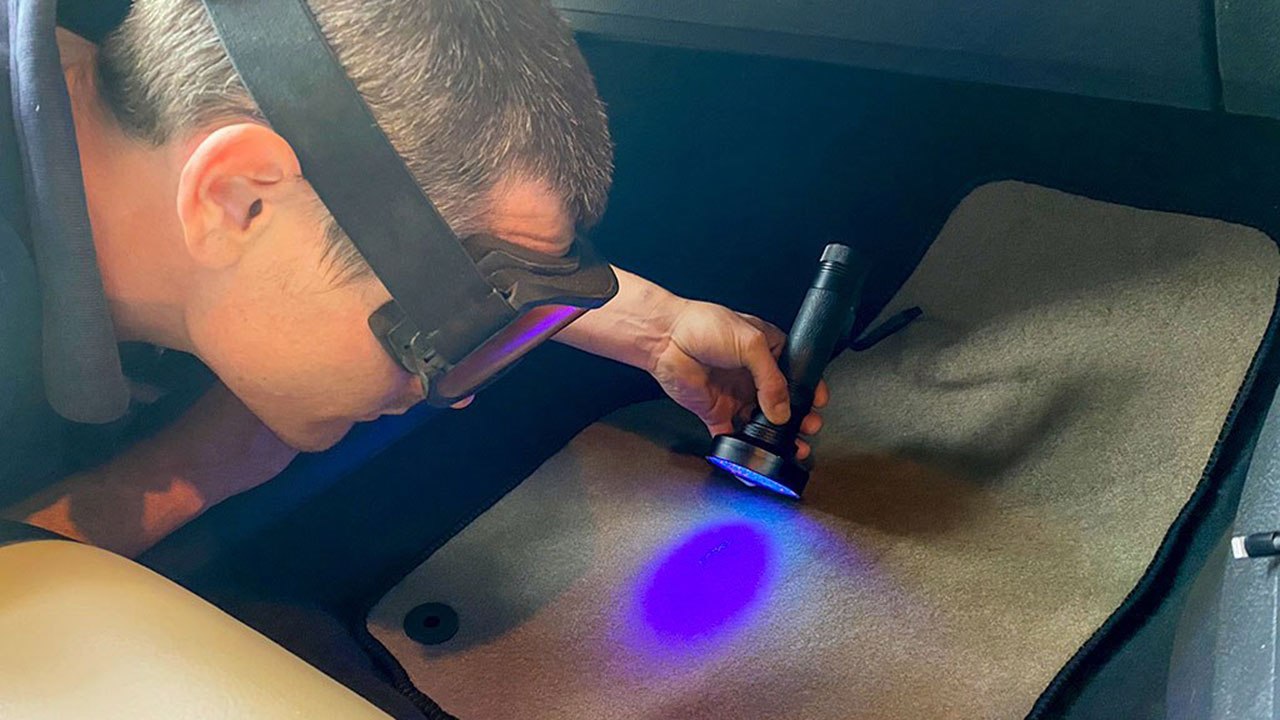
There's loads of information on the web about removing bad odours from your car but there is a deficit in useful advice which will tell you just how tricky it can be to remove bad smells.
There's much more to this subject than at first meets the nose.
"How do I remove bad smells from my car?"
The only guaranteed way to remove bad smells from your car is to remove the source of the smell. If a trace of the substance causing the smell is still in your car, the smell will remain, so you need to wash it out. Air fresheners only mask the smell. No amount of baking soda or white vinegar will soak it up. Cleaning is the answer. In detail.
Let's be honest, getting rid of car odours can be difficult!
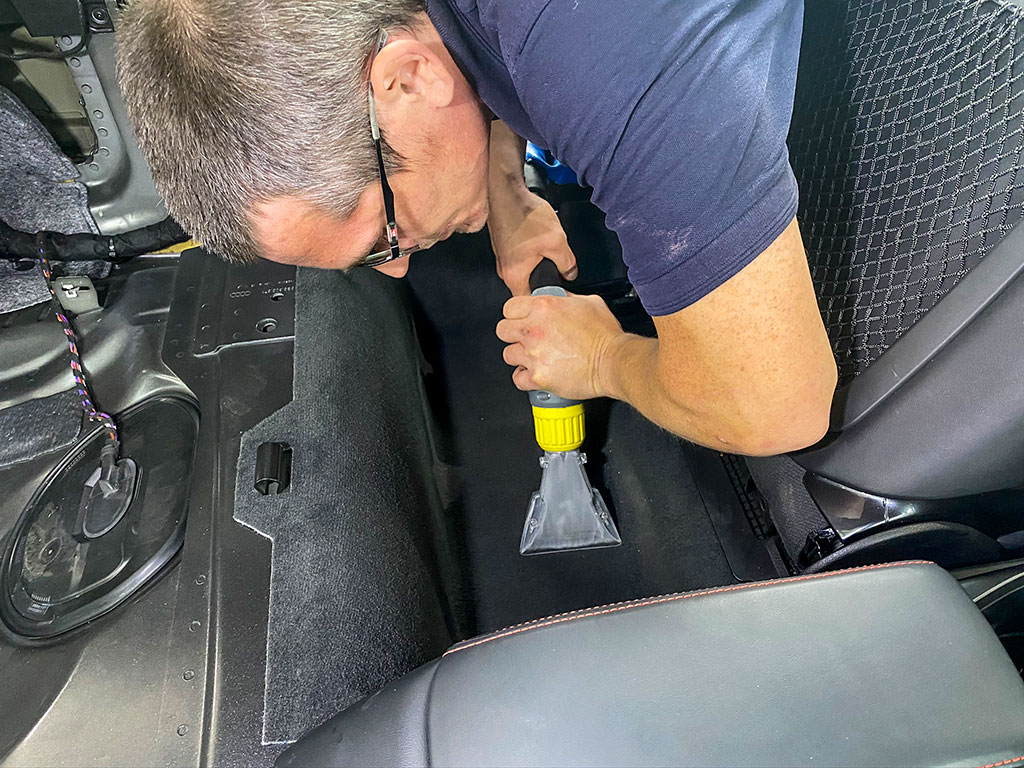
Never say never, you could get lucky! Washing things down with white vinegar, sprinkling around some baking soda, and giving your car a dousing in Febreze might just work for you, but I wouldn't take that bet.
We have learned from sour experience, but we are willing to share what we have learned.
Our customers have been asking us to remove car odours for the last 30 years, and for 20 of those years, smelly cars are something we have specialized in. We have specialist machines, gizmos, and exotic chemicals which we import from America and Canada, lots of science-based training and experience, and yet it can still be difficult.
80% of the cars that are brought to us for professional odour removal have already been cleaned, detailed, shampooed, and treated with 'odour bombs', air fresheners and home remedies. And yet, the smell persists.
The basics of car odour removal
The bottom line is that "something" that smells has got into your car. Until you get that something out, it will continue to smell. You can mask the smell, disguise it, cover it up, but it will still smell.
Unless you have had some kind of chemical spillage, then the chances are that your problem is organic matter which is decaying, bacteria is feeding on it, and you are smelling the results of that biological process (even with cigarette ash, that's why fresh ash smells different to stale ash).
Let's state the obvious, that you cannot see smells. Yet, they are physical, the particles which are getting up your nose are microscopic. The source of your smell may also be microscopic traces, too small for us to see, but a large banquet for smelly bacteria. This is where it gets difficult, how do you fight what you can't see?
The simple answer is to clean absolutely everything. Simple in theory, expensive in practice. There are no short-cuts.
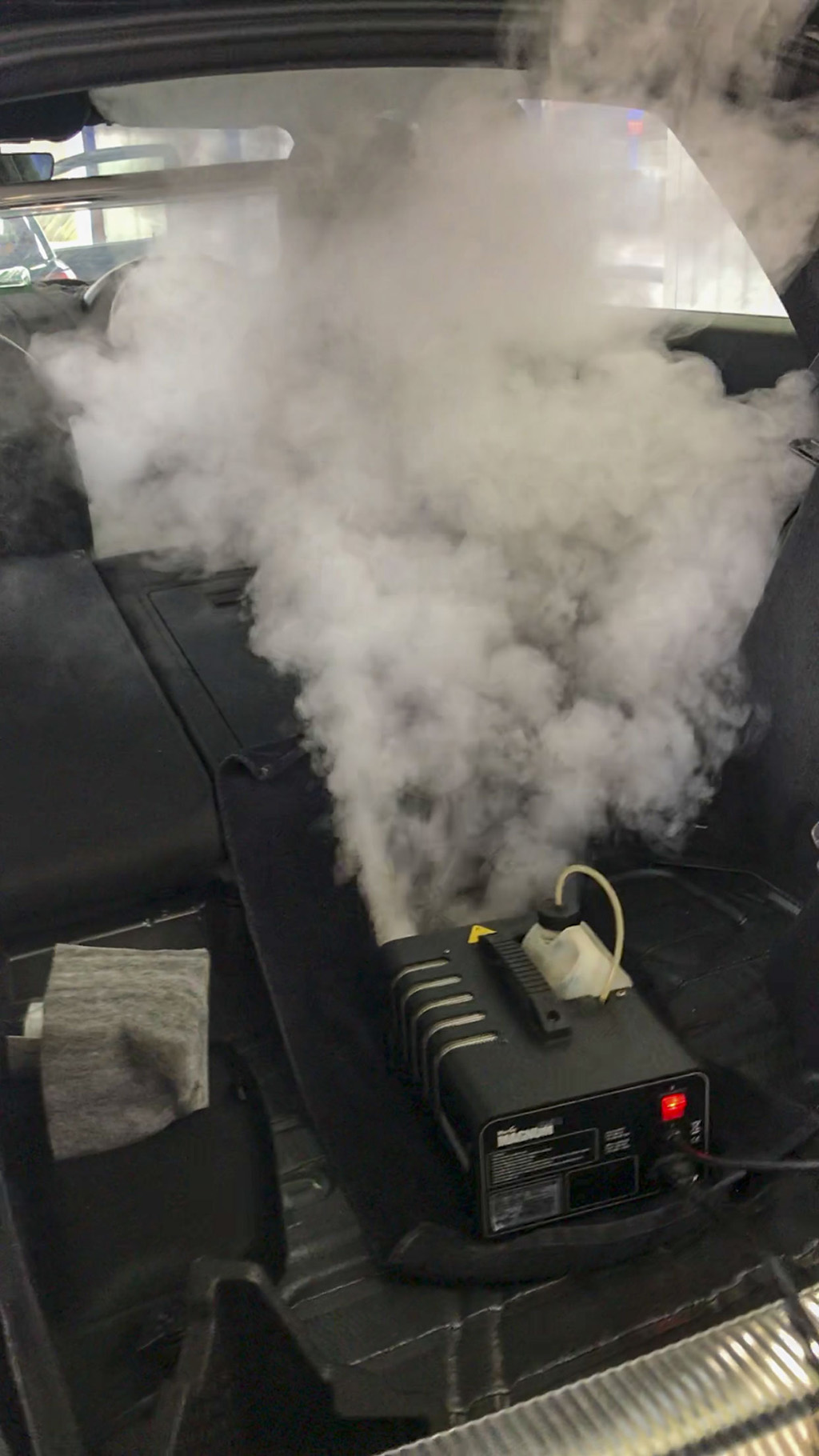
Mystery Car Odours
By far the most difficult smells for us to deal with are the ones that smell a bit like this, or a bit like that, but nobody can quite put their finger on what it is or where it's coming from. This often happens when somebody buys a new car. When they got the car, all they could smell was the air freshener, and then a while later the temperature of the car reached 38 °F, and suddenly, it smelled a bit fusty. It is difficult to know where to begin with these, although we usually start with black-light, trying to see any stains which might indicate where it's coming from.
Another reason a smell might be a mystery, at least for us, is that our customers are not always completely honest with us. A couple of times this was because they didn't want to tell us that their car might have been sabotaged by somebody they had upset. Other times it was because they had been doing things in their car that they probably shouldn't have been doing... I'll say no more. We don't judge. It is difficult to tackle an odour if the customer tells you one thing, but the source is actually something entirely different.
Underestimating the problem
It is often the case that people don't realize the extent of their problem. They may have spilt something like milk on the carpet in the boot and mopped it up and washed it out. They don't realize that it sloshed under the back seats and soaked into the carpet underlay. Another example is cars that have been smoked in, it is difficult to imagine all the places smelly cigarette ash can get unless you have taken a seat apart... more on that later.
Making car odours worse
What most people do when they get a spillage is attempt to clean it up as quickly as possible, but if they try to wash it out, there's a good chance they are making things worse. Milk will always smell, no matter how much you dilute it, by soaking it in soapy water you are likely just helping it to spread and soak down into the foam seat or carpet underlay. If you spill your latte on the seat, you may have washed it enough to get rid of the stain, but it's still going to cause a stink.
Worse is trying to clean up oily chemical products using water. Petrol, diesel, turpentine and oil-based products will float on water and even if you use a soap with a strong emulsifier which breaks down the oils, unless it's extracted it will stay in the car and cause odours.
Are home remedies useless?
They work really well when used appropriately. White vinegar is actually an amazingly good degreaser... it has its own odour, but this doesn't last too long. Although on balance, there are better more effective cleaners and disinfectants, Milton Fluid is something we occasionally use on hard surfaces and Zoflora is a firm favourite with the ladies.
It is assumed by many that bicarbonate of soda absorbs smells much like activated charcoal does, but from what we have researched, it is just a fungicide and mild disinfectant... although it does seem to have some ability to absorb odours, probably because its partials have large surface area much like charcoal. It is essentially what products like Shake'n'Vac and Neutradol are, which are also great products, we use similar professional odour eating products which come in the form of crystals or granules, they last longer and don't leave powdery residue.
On balance, I would suggest using one of these carpet freshening powders. They aren't much more expensive, and I'm certain that the chemists at Glade and Neutradol know what they're doing and have mixed up potions a little more effective than just baking soda.
We're not going to knock Febreze either! One of the reasons I'm such a fan of Febreze is that they have a whole page telling you how it works, which gives me confidence that if I'm not just spraying around some perfume.
When I'm away at work, my dog sits on my chair and, as a consequence, it smells doggy, which drives me crazy. While in ASDA, I noticed that Febreze was on special offer, so I came away with three bottles. I have been spraying it on and around my chair for a week, and it does seem to work... for a while. But after a day or so, the smell comes back. That doggy smell has got deep in the chair and as effective as Febreze is, the chair really requires a deep clean to get rid of all the oils and dirt which is the source of the odour. While Febreze and similar products can soak in and get at that surface dirt, they cannot get deep into an old chair (I'm getting a new chair. It's about time).
Biological washing liquid is another product which can help. The 'biological' part is important, as this means it contains enzymes.
If you can get this to work, it will solve most odours.
Your car smells because you have something in it which bacteria can eat, and you smell the bacteria. When you introduce enzymes, the enzymes eat that dirt, meaning that the bacteria starves and dies... then the enzymes eat the dead bacteria. Smells gone! Problem solved!
It's great in theory, it's a little more difficult in practice because enzymes only really work at specific temperature ranges. Too hot and the enzymes die, too cold any they are lazy and do-nothing. As a general rule, enzymes work on a bell curve with the zenith being at about body temperature, 37°c - 97°f. As soon as you put enzymes in your car, they will begin to cool down and stop working, and as previously mentioned, if you are sloshing soapy water around in your car, it's very easy to spread the problem and make things worse.
We have professional products with enzymes engineered to work at lower temperatures, but even so we still have to control the temperature (and these products are seriously expensive).
In conclusion, when it comes to home remedies and household products, they can work, but they are not always ideal, and you still need to put in the work to remove the odour at the source. You can't just spray or sprinkle on a product and expect to get results.
Hypoallergenic - The one benefit of things like baking soda and white vinegar is that they are far less likely to upset people who are sensitive to perfumes or strong chemicals. We have on occasions been asked if we can provide our service to people with sensitive skin or noses, and it can be done depending on the cause of the smell.
Targeting car odours
From what you have read so far, you may be thinking that the way to remove car odours is just to clean the entire interior and that will take care of it. There's some truth to that, but different problems do require different solutions. A smoke damaged car requires an entirely different approach to a car with spilled diesel odours, which is different to a car which had shopping left in the boot while the owner went off on holiday for a fortnight (yes, it happens).
We have a range of products that we use for different problems. There are products specifically to clean urine, products for breaking down chemical spillages and everything else in-between.
Smoke odours
Cars with smoke odours can be broken down into three categories. First are cars where there has been a fire or the car has been in or near a building that's been on fire. It happens more often than you might think that a fire breaks out in a car showroom or mechanic's workshop. The fires generally create lots of soot and thick acrid smoke which gets in the car and is quite difficult to remove. However, if this has happened to your car, it's unlikely that you will be attempting to fix this yourself. The garage or their insurance company will most likely be paying a professional to repair the damage. But be warned, if you are thinking of buying a category C or D write-off, you should give it serious consideration.
Secondly, come vehicles where somebody has smoked cigarettes in the car. Thirdly are cars where somebody has been smoking something other than cigarettes. Some smoke odours can be a little more pungent than others, they are generally treated the same way, but some people can be sensitive to the slightest trace.
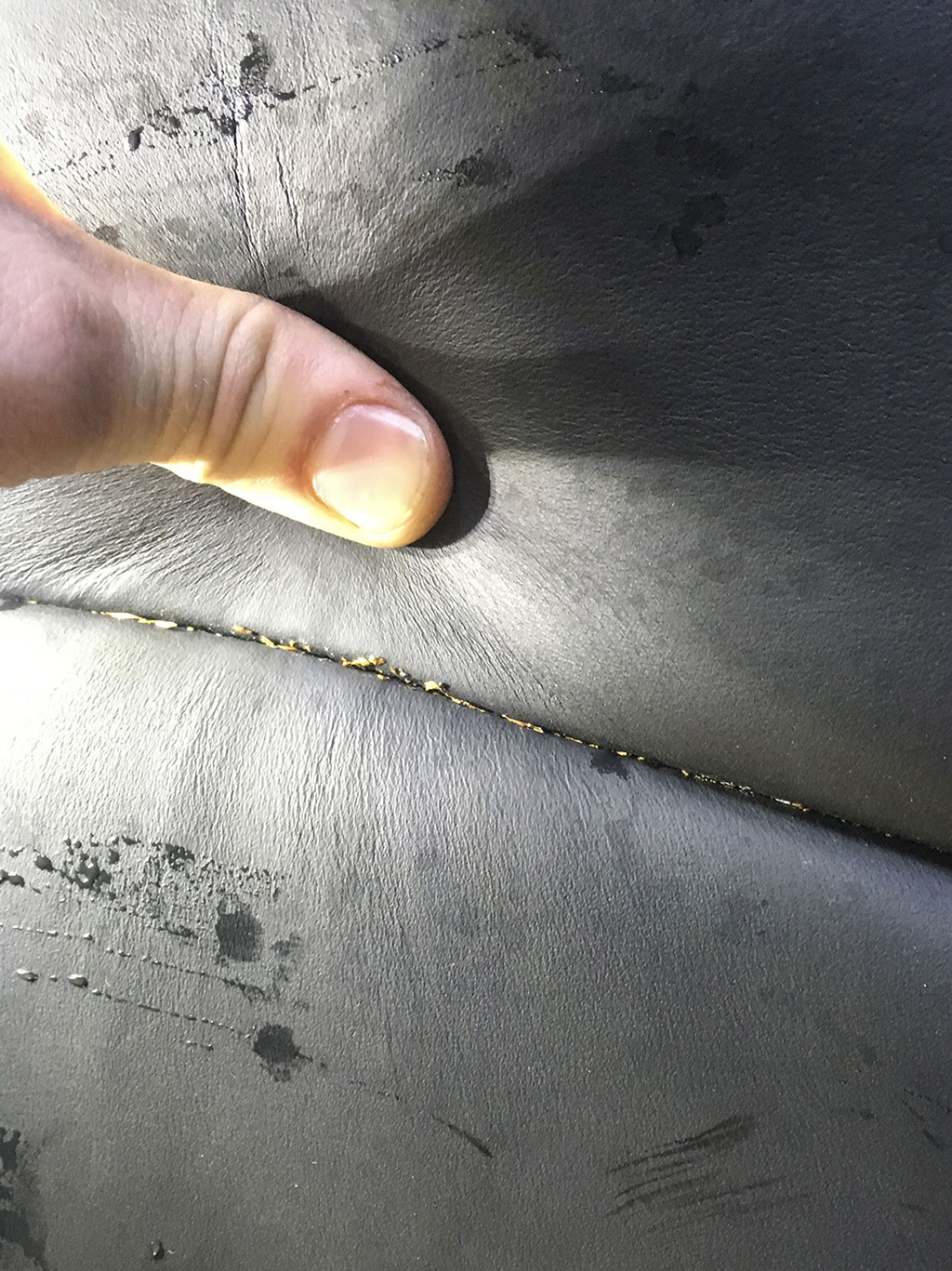
These days, people aren't allowed to smoke in company cars or lease cars, but they still do. What tends to happen is that people smoke with the window down instead of using the ashtray. What this means is that the air rushing in from the window blows the cigarette ash all over the car. There will usually be ash on the back seats and parcel shelf.
Odour from cigarettes comes from three different sources. The smoke particles, the tar which coats cool, hard surfaces, and the ash... and in the case of combustibles such as pipe-tobacco and other herbs (we don't judge), you can usually find a sprinkling of it under the seats.
For us to completely remove the smell from cars that have been smoked in, first we have to remove all the ash. Aside from a shampoo and vac, we will usually take apart all the plastic trim from the steering column. You would be amazed at what we often find there, and it's not unusual for there to be such a build-up of ash that it falls back behind the dashboard and gets into fuse boxes. It's also likely to be all around and in the seat runners, the seat base and centre console. It is not unusual for us to dismantle and remove parts of the interior so that we can properly get to the carpets underneath.
All hard surfaces will get coated in tar, including glass and plastics. Wiping these down is not enough, they need to be thoroughly washed to remove all residue. This is not a problem for the surfaces we can see, but smoke hangs in the air and gets everywhere, which means it's up underneath your dashboard, coating all the hidden surfaces, ducts, cables, wires etc. Obviously, we can't take the entire car apart and give everything a bath, but there are other solutions. We use ozone machines, wet and dry foggers to reach the places we can't see. We can run various chemicals through them which will oxidize, neutralize, deodorise, seal and/or add odour in a process called pairing.
Pet odours
Probably the second most common odour we get asked to tackle are pet odours. This is generally from people who have just bought a car. It's likely it was detailed before they got it, it had a nice air freshener in it, and they didn't notice the smell at first. Then a warm day comes along, and the car gets to that magic temperature where the bacteria population explodes and decides to feast on all the doggy residue.
If you have ever owned a dog, you will know that once in a while their fur gets fatty. It isn't greasy like human hair, it is more soapy like wool fat (lanolin), which is essentially what it is. This fat is a banquet for bacteria on its own, but our four legged friends will be unlikely to wipe their feet before hopping in the back of your car, and so will track in all sorts of organic material.
This kind of problem isn't too difficult to deal with, it is essential to use a good detergent to wash out all the lanolin and other dirt from the surface of seats and carpets, as well as removing the pet hair. It will get down the back and under seats and, in an estate car, under the boot carpet.
Bio-active Enzymes can help get deep into seats where a wet-vac can't get to, followed by anti-microbial, antibacterials to prevent or slow down the return of bacteria.
This is all fairly straightforward; however, it doesn't deal with the main reason people come to us with pet odours.
Pet urine odours
This is where we see lots of advice on the Internet that involves white vinegar and baking soda. Maybe this works on your carpet at home, but home carpet is thin. The back seat of a car has inches of foam sponge and frankly, once something gets into the foam, it is difficult to wash out. If you could pick it up and wring it out like a bathroom sponge, it might be a different story, but as it is, the best option is to take the seat out and flush it through with water.
The products we use are especially formulated for pet urine, and we find this is what works best. There are plenty of pet urine cleaners and odour removers on the market, so don't mess about, use these. Many of them are advertised as being bio-active with enzymes and these may cost more money and while they may remove stains, we haven't found enzymes to be especially effective at dealing with urine odours. The product we use does not contain them.
Another alternative is to just replace the seat or back carpet. Pet urine can be quite corrosive and if it has soaked through to the frame and springs, and caused damage it might be the only solution anyway, but there's also the 'Eww' factor. Plenty of people would much rather have the peace of mind of knowing the problem is gone. Replacing these parts with new, can be rather expensive depending on the make and model, but it might be worth looking at the used parts market.
Other organic odours
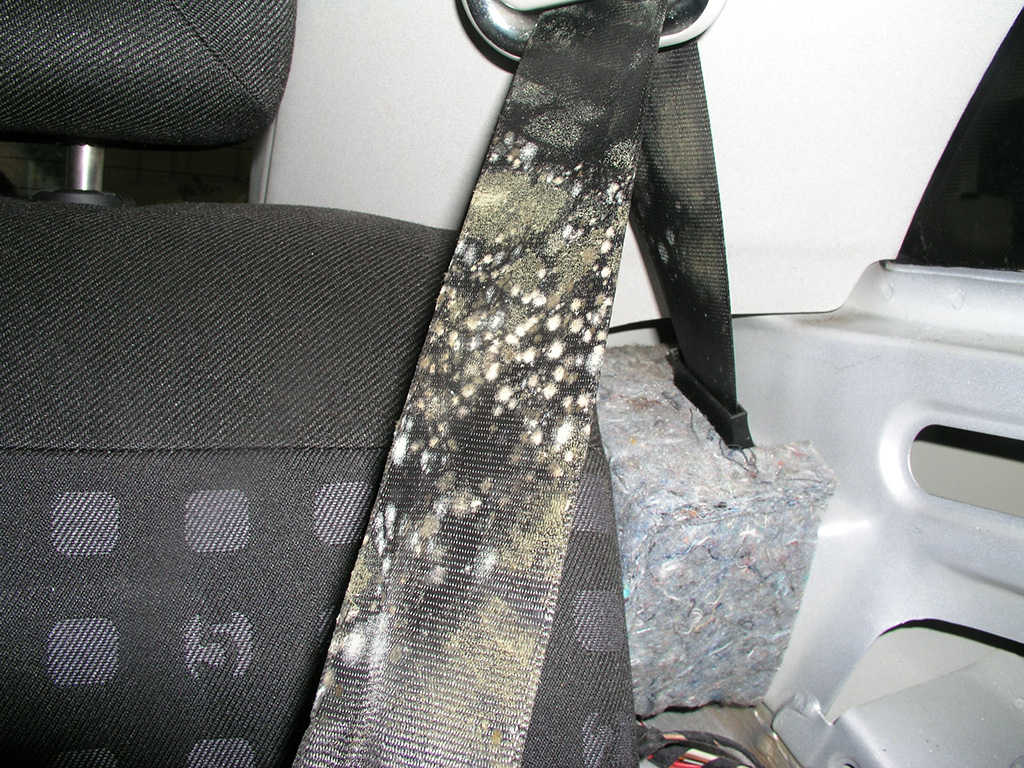
The most common organic odour we tend to deal with seems to be the smell of rotten milk. This probably isn't because it's the most common spillage, it's just down to it smelling so bad and being so persistent. Sometimes it is actually that somebody has had a plastic bottle of milk in their shopping split, other times it's that somebody has spilled a baby bottle, milky coffee or milkshake.
We deal with odours from broken bottles of wine and beer, spilled take-always, and, of course, there are instances where people have left shopping in a car and forgotten about it or gone on holiday.
We once had a couple bring us a car which they had parked at Heathrow for a couple of weeks. They said they could smell the rotten chicken while they were still on the coach approaching the car park. To remedy this, we actually had to repaint some of the spare wheel compartment as the stink had soaked into the untreated paintwork.
We have seen cars that have been sabotaged with prawns stuffed inside the seats. By the time we tracked down the exact nature and location of the problem, the car was creating a smell which I will regrettably never forget. We did remove the smell from the car, but the two front seats were goners!
We have dealt with cars for the police, and I can say with some authority that when four officers are living in a car on stake-out for a week it can smell like a school locker room next to a rubbish dump.
Some people have had a leak causing water ingress, or maybe they just do many short journeys so that in the winter, the car doesn't get a chance to warm up, windows get steamed up, kids are in and out of the car with wet shoes and coats and the car gets damp leading to a damp, musty, mildew smell.
Often people don't know what the smell is that's annoying them, they buy a car, and it has a smell which is a little off, it's alien, it might not even be that unpleasant, but it's annoying.
The answer to all of these problems is roughly the same, find the source of the smell, remove it, clean the whole interior and deodorize it.
The reason we have to clean the entire interior is that you smell mould and bacteria which are eating the organic substance. Those spores get everywhere, as well as just up your nose. They will be sitting there waiting to devour any further organic material you introduce to your car, for example, any dirt or oils on your hands where you touch your seatbelts. We aim to clean it all, kill it all.
Chemical spills
These are generally spillages of fuel such as petrol, diesel, kerosene. Other automotive products such as antifreeze, engine oil or brake fluid, but can be anything brought back from the DIY centre such as paint thinner.
These can be really difficult to deal with, and it may well be worth asking if you are covered under your insurance.
In theory, all you have to do is use detergent which is good at emulsifying oil-based products, and you can wash it out. However, these products, being oil-based, can damage oil base carpets and plastic car trim. They can permeate surfaces and get into the paint on the body of the car. Worse, if they have spilled into the car in any quantity and washed into drainage holes and box sections.
We have done these for insurance companies where we have completely stripped out the car interior and flushed it through again and again with gallons of detergent and still, you can get a faint smell of fuel.
The biology and psychology of odour
It probably won't come as any surprise to anybody to learn that women really do have a better sense of smell than men. Young women have a better sense of smell, pregnant women have the best sense of smell, and older women start to lose their sense of smell in their fifties. In short, there is a correlation between smell sensitivity and fertility.
"Women's olfactory superiority has been suggested to be cognitive or emotional, rather than perceptual." Science Daily
Evolutionary psychology is a science in its infancy, but I think that I'm not going to get much pushback if I suggest that women have a stronger sense of smell because of their role in raising children. Bad smells evoke feelings of disgust and revulsion because they are a clear sign of danger. Disgust is part of our behavioural immune system.
I have read articles from the perfume industry (who have long asserted that women have a better sense of smell regardless of scientific research) that this superpower that women have is a curse as much as a blessing because there is a continual assault of odours and need to processed and evaluated, which can frankly be stressful if you are prone to hypervigilance. As an aside, there is also research that suggests that roughly half the population are more prone to disgust.
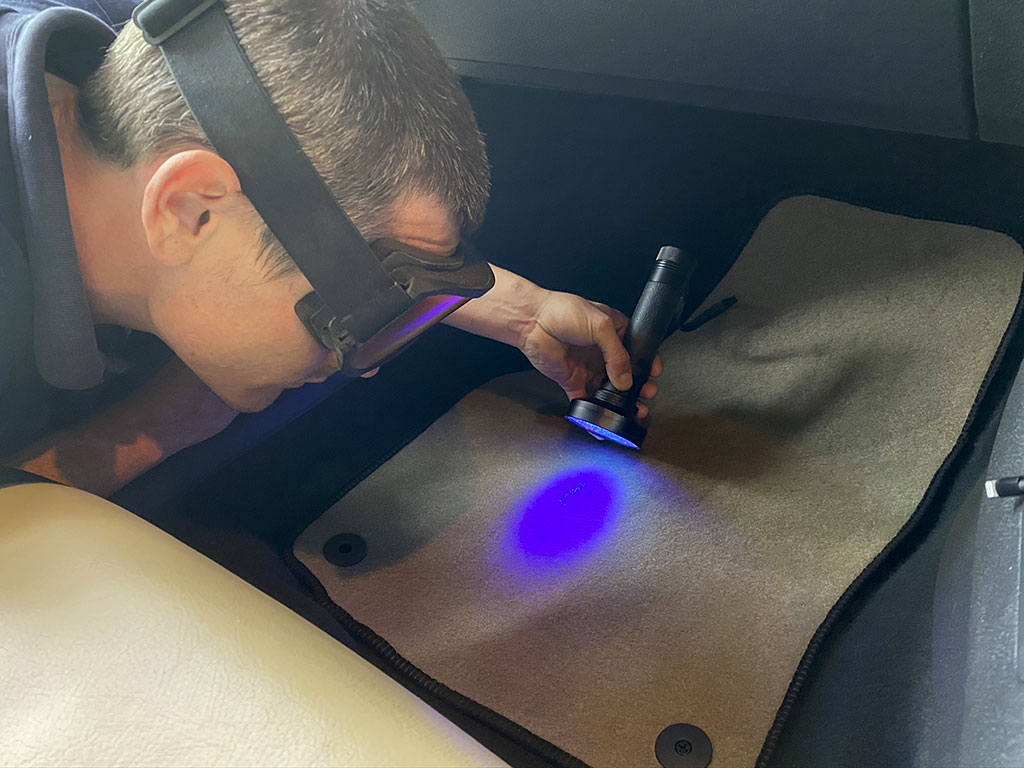
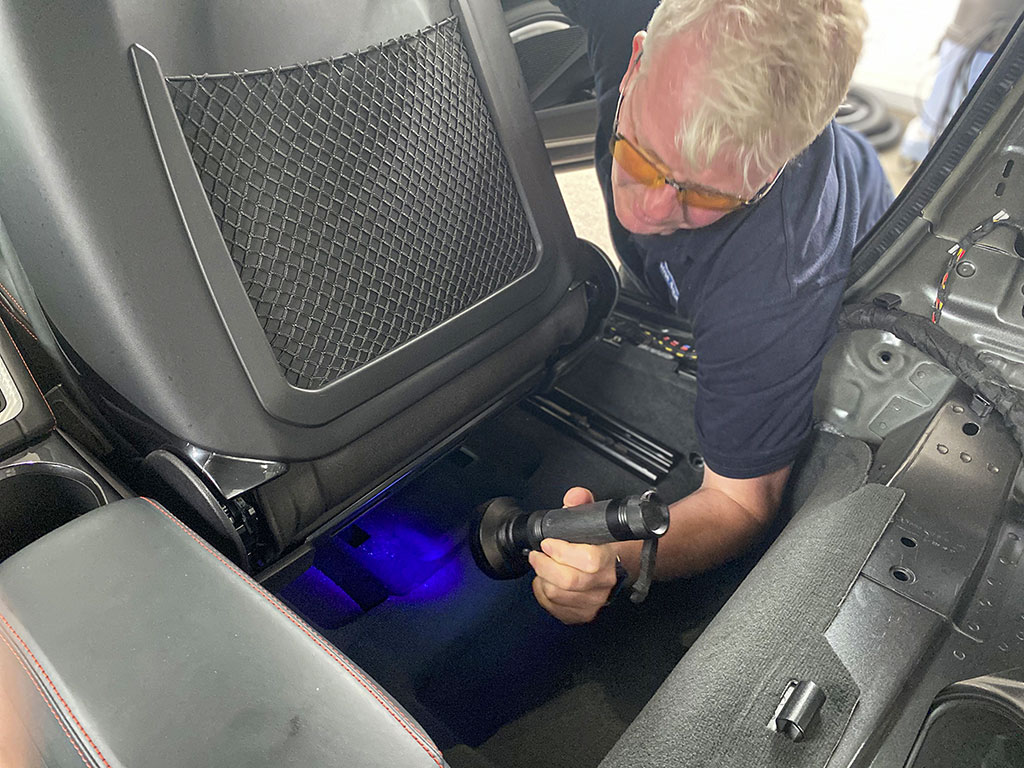
Little wonder then that most of our customers for our car odour services are women or men who say, "I just bought this car... I love this car. But the wife doesn't like the smell".
And in light of all this, it might not surprise you to know that when we want to check a car to ensure our odour treatment is successful, we find a young lady who is conservatively dressed and ask her to have a nose around.
There is one more phycological or physiological aspect to car odour removal which we must address. We don't know of any scientific research into it, but it seems to be the case that once you have smelled something you don't like, you can become attuned and locked into it. It's a kind of hypersensitivity. It is as if part of your brain is constantly scanning for even the slightest traces of it.
As we said right back at the beginning of this article, what you are smelling is often the result of bacteria and microbes... billions of them. There is a chance that even after the most thorough treatment, there are still traces of them.
On the other hand, my own experience would suggest that we can become prone to false alerts. It has long been known that smells trigger memories. For me, it would seem that this can also work the other way around! While writing this article, I have been remembering some of the worst vehicles we have ever had to do, and I could almost swear I can smell rotten prawns.
When you couple this with the "Eww" factor, it may well be worth considering selling the car you have a problem with. This isn't to imply that you should do nothing about the odour, obviously you'll get more for your car if it doesn't stink. But it's surely the case that the smell can be reduced to the point when nobody can smell it but you.
A case in point is one of the vehicles we mentioned earlier which had diesel spilt in it. It came to us via an insurance company whose assessors passed the car. But the lady who owned it (who had two small children under three) could swear she could smell diesel. In the end, the insurance company gave her a new car, that doesn't mean they wrote off the old one, it was put up for sale, and I'm sure the new owner never smelt anything but the scent of Kentucky Blue Grass.
Method used by the professionals
We have a vast array of chemicals and equipment for removing bad smells from cars and cleaning up whatever causes those odours. Even so, there's no magic solution, you still have to remove the source of the odour to prevent it coming back, but we do have a few tricks up our sleeves which give us an advantage over anybody trying to do this at home.
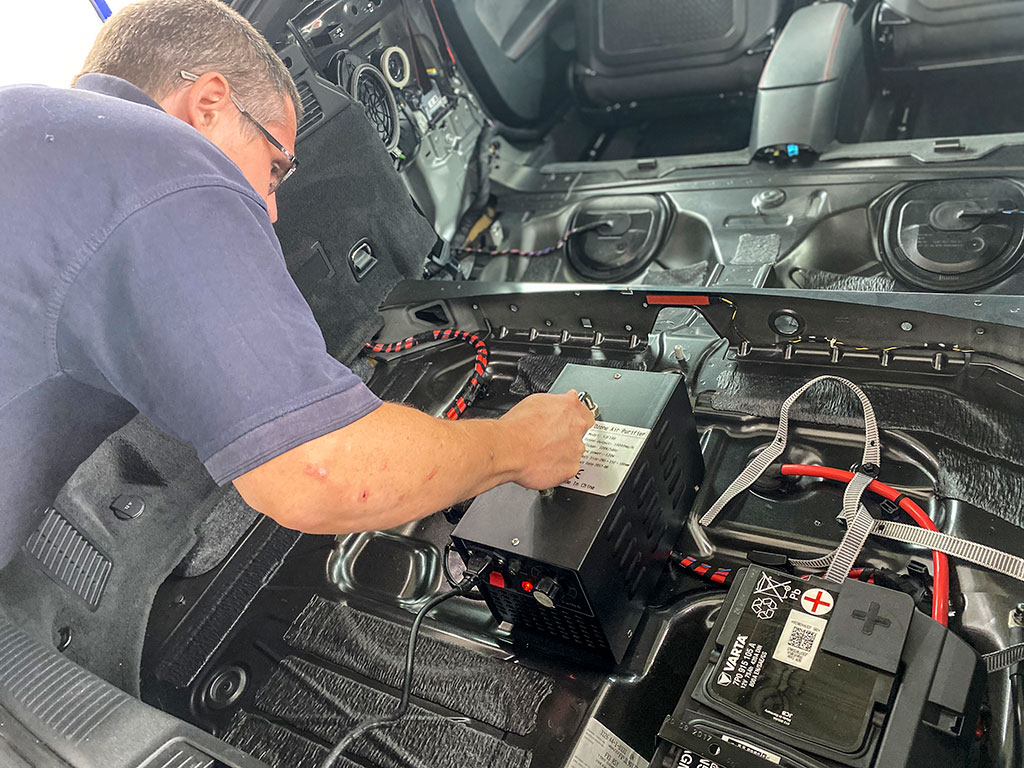
Ozone Machines
Ozone (O³ trioxygen) is an unstable form of Oxygen (O² Dioxygen) with an extra atom of oxygen which really wants to leave and join to something else! If it achieves this, it oxidized whatever it comes into contact with, stealing an atom from it. It really isn't good for anything organic, including us (so it's not a good idea to breathe this stuff in).
Ozone machines we use are medical equipment, they were used in surgical theatres while they weren't in use to keep them sterile and still have some commercial applications for air purification which probably doesn't actually work. There is some controversy about ozone machines, largely because they have been mis-sold, misused and manufacture's claims (in America, where they were popular for a while) cannot be substantiated. They are not good at cleaning air and for them to work effectively you have to create ozone levels which are hazardous to human health… which is okay for us as we use them in empty cars.
We have machines which contain an ultraviolet light which create ozone via a corona discharge from the oxygen in the air, we can leave these in the car for a little while and the ozone will get practically everywhere and oxidize any organic material it touches.
Ozone is in the air all around us all the time anyway, and over time it will oxidize just about anything. An example that Gary likes to use is that if you open up a pyramid after thousands of years, it's unlikely to smell of much. Anything that's organic will have been spent and all odours long since dissipated. But it takes time. By introducing high levels of ozone, you are helping to accelerate this process.
We use them, and they work, but their usefulness is limited. They really do work on an atomic level, which sounds cool, but in practice, ozone only works one atom deep, creating a thin ozonized crust over whatever smells. This means that if the surface of the offending substance is disturbed, the smell returns.
Where we find ozone useful is for reducing the odour of cleaning products. Many of the products we use for odour removal have strong odours of their own, and when wiped over every surface of the car they can be a little overwhelming. A dose of ozone helps tone down the smell.
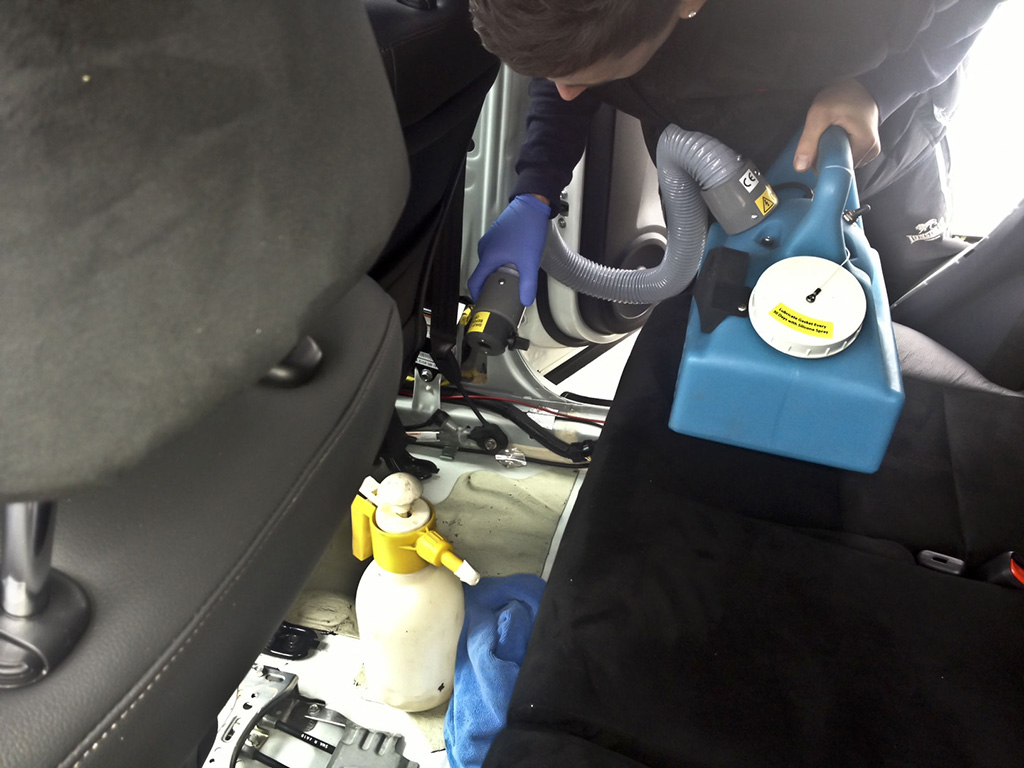
Wet foggers
Foggers turn a chemical product into a fog. With wet foggers this is a vapour, generally somewhere between the mist you get from an atomizer spray and steam. It's not unlike vaping.
This vapour is wet and therefore heavy, so it doesn't hang in the air, but it can get into places you couldn't wipe off with a cloth. Wet foggers are perfect for applying antibacterial and anti-microbial products, enzymes and active deodorants.
While we are on the subject, the antibacterial and anti-microbial products we use vary, but generally, we use the same products which are used in the food industry or hospitals and are approved and certified either in the EU or US or both. One of the reasons we use these products is that we often do work for insurance companies, and they like to see we're using a procedure, doing everything we can with the best products. We want to kill the germs, but use products that are safe for humans and their pets.
(Dry) Thermo-foggers
Dry foggers work by heating the product, which is usually some kind of oil, and turning it into a vapour which is more like smoke. This hangs in the air and so can be pushed through air vents and up under the seats, dashboard and all those hard to reach places.
There are basically two kinds of products we put through a dry-fogger, one of which is a little like a varnish. It will get onto everything and form a coating which, if left, dries like a hard shell. This is useful for certain kinds of smoke odours, usually ones where there has been a fire where plastics and rubbers have burnt and coated everything with a tar-like substance which has a particularly strong and acrid smell. While not too difficult to wash off, It does have a tendency to get everywhere, including up under the dashboard. It just isn't economically viable to take the dashboard apart and clean every wire and connector. This product will coat the tar, soak into it and set hard, sealing in the odour.
More interestingly, we use a range of perfumes through these which put a smell into your car in a technique called "pairing".
Pairing odours
Let's get one thing out of the way... you can't just use an air freshener to mask a smell. It doesn't work quite that way. Spraying Cologne around your car might mask a smell for a short while, but not for long. However, there is a way to blend smells to change the way we perceive them.
If you have ever shopped for perfume or cologne online, you may have seen them described as having headnotes, heart notes and base notes. As in music, you blend different notes together to make a chord. As you are aware, when an expert perfumer mixes a munch of different smells together, you come up with something entirely different (which you can bottle and sell for a lot of money).
To put this in layman's terms while mixing metaphors and analogies, our noses and brains aren't identifying every chemical molecule we breathe in. It takes a selection of markers and assigns an identification to it. So, what I described earlier as a note, is broken up into a code (watch the video!).
And so, it seems if you pair certain smells with others, you can trick your brain into identifying it as something else. This is precisely what we do with pairing. It is a little like hiding a bum note in a chord.
- Mint - will pair with the smell of mould or damp, musty odours.
- Citrus - will pair with smoke smells and sour smells such as rotten milk.
- Cedar - pairs with woody organic smells such as tobacco.
- Cherry - will pair with sweet sickly smells or vomit.
- Kentucky Blue Grass - will pair with chemical smells like petrol.
As always, this doesn't just mean we can put these in your car, and it will kill the odour. We still remove the source of the odour (to the best of our abilities) disinfect and deodorize before using pairing as a final step.
The last resort
The final products in our arsenal are deodorants. We, of course, use these fairly early in our process, but if we have smells which are particularly difficult to deal with, we have a product called Last Resort, which is touted to be the world's most powerful deodorant. It is an American product and over the pond it's what they use when the source of the problem was a skunk... thankfully something we don't have to deal with in the UK. It has its own strong smell which is sweet and fruity, some people like it, others don't. But it is generally an improvement on whatever smell we are trying to get rid of.
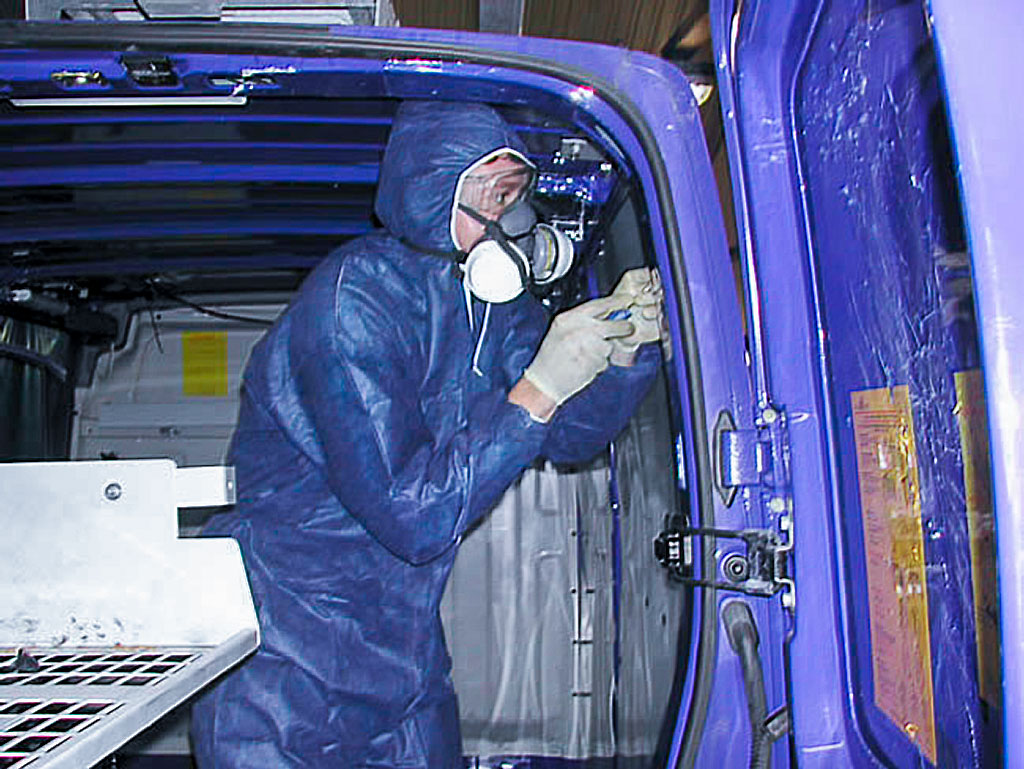
We don't do things by half!
As we are being honest, we can admit that over the years we haven't always got it right. When we haven't, it's usually because we or the customer have underestimated the extent of the problem. The Pareto Principle doesn't apply here, you have to give it 100% and blitz the problem and as we keep repeating, that means doing whatever it takes to remove the source of the odour.
In Conclusion
We hope this articles has given you a better idea about what can be involved in car odour removal and the lengths that specialist companies go to kill those smells. It is something you can do yourself at home using odour removal products you can buy from the Internet or local supermarket, especially if you are willing to put in the work. If, however, you are having problems with persistent odours, we are here waiting for your call.

by Danny Argent
technical writer, training and education.
Related Videos
Related Blogs
Here are some more of our latest #OdourRemoval blogs
how to get rid of mildew smell in car
Musty, damp smells are distinctive and annoying, but can also be a health hazard. We will look at what causes mildew and how to get rid of musty smells.
Read ArticleDo you have a smelly car?
What’s that smell? How many people think that, but don’t actually say it. ''I’ve just bought a smelly car and its smells of something I can’t quite describe. Is it the smell of somebody’s dog? Is it the smell of smoke? Maybe something has been spilt ...
Read ArticleGetting rid of car odours for good
What is nicer than driving a fresh, clean vehicle? On the other hand, how distracting is it to put up with bad odours, especially if you struggle to find the source? With New Again you can find a fast, effective service. Our team provides the most reliable ...
Read ArticleCar Smell Removal FAQ
This 'Frequently Asked Questions' page should answer most of your questions and clear up some of the old wives' tales about odour removal.
Read Article
Can We Help You?
"We can offer specialist advice on the best car service to suit your requirements"
When bringing your car to New Again, we often ask you to explain exactly the reason for having your car Protected, Valeted or Repaired. Once we understand exactly what it is you are trying to achieve, we will appraise your vehicle using our detailed appraisal check-sheet allowing us to identify areas of concern and tailor specific services that match your requirements and budget.
If you are not sure what service you need and would like to speak to one of our technicians, simply request a callback by filling in the form on our contact page.
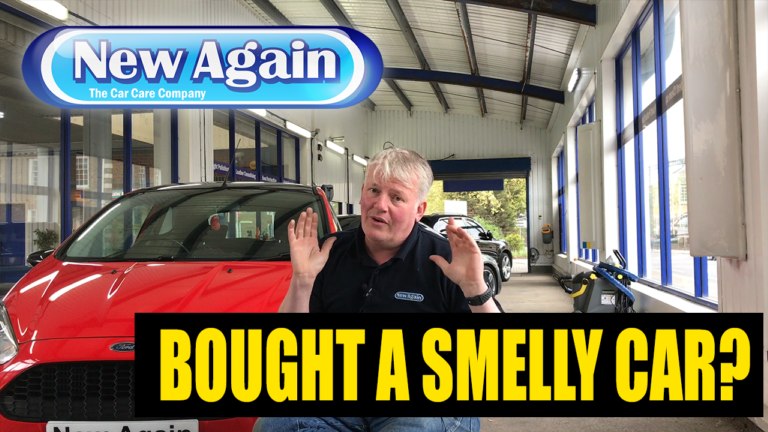 Did you buy a smelly car?
Did you buy a smelly car?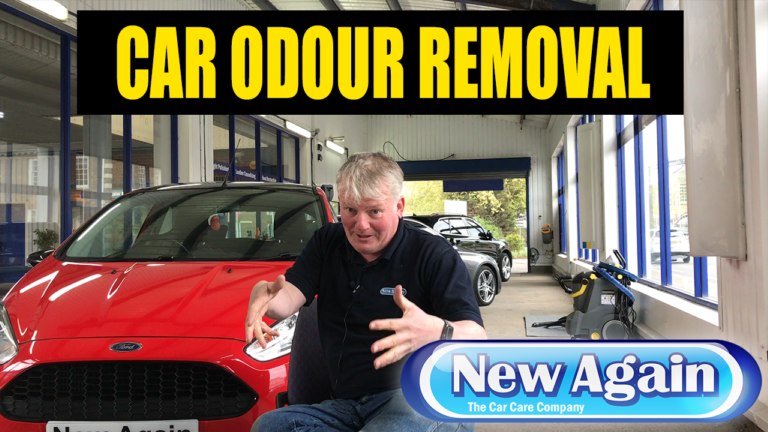 Removing odours from car interiors
Removing odours from car interiors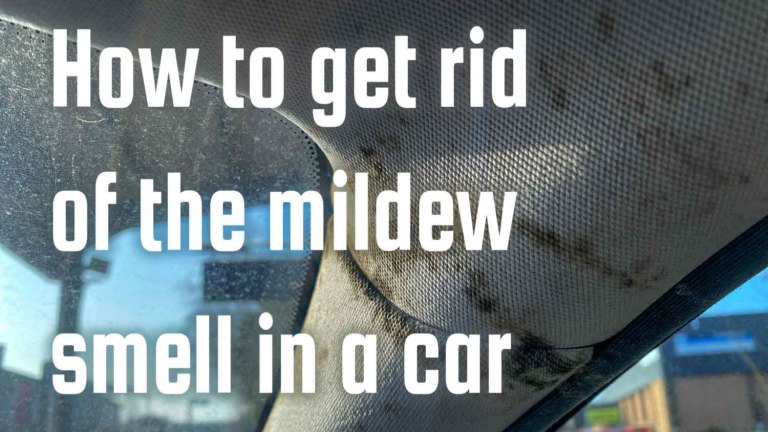
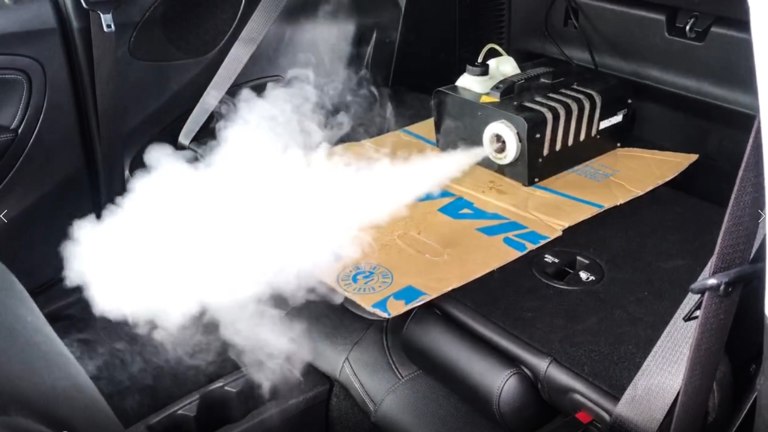
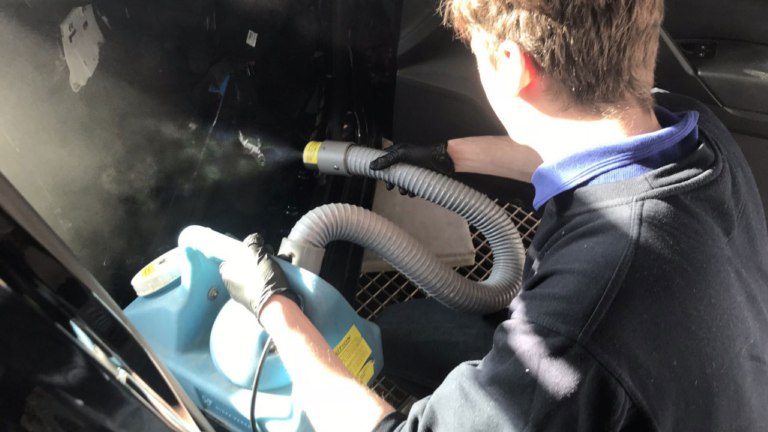

Share this blog